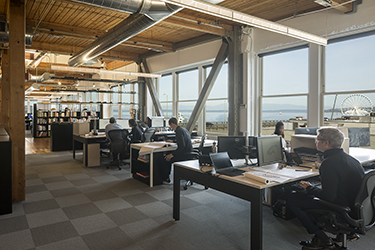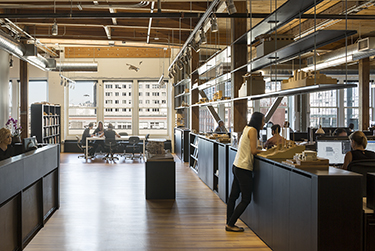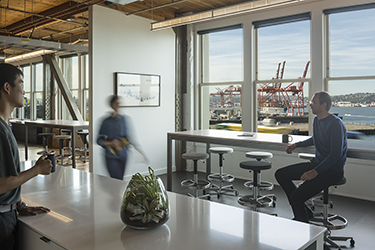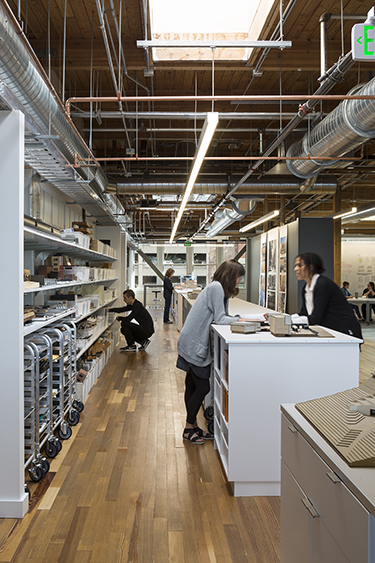|
Subscribe / Renew |
|
|
Contact Us |
|
| ► Subscribe to our Free Weekly Newsletter | |
| home | Welcome, sign in or click here to subscribe. | login |
Environment
| |
 |
March 23, 2017
Next frontier for sustainability? The people inside all those green buildings
The Miller Hull Partnership

Hellstern
|
Until recently, many designers and building rating systems primarily focused on building performance.
Where once only a few parameters — like daylighting or increased ventilation — supported the health of the people in the building, the focus is beginning to shift. The building industry is now placing more emphasis on concerns such as human health and indoor environmental quality.
While Miller Hull has long taken occupant health into account in our design considerations, greater awareness and new tools are helping to make designs for health more acceptable in projects around the world.
Companies can offer a new hire almost any financial benefit that can be dreamed of, but still find the need to differentiate themselves and compete for in-demand staff. To stay competitive, some companies are providing office spaces with reduced toxins or air- and light-quality standards that far exceed their competitors’ standard buildings.
Employers now have real data to validate the benefits of such design choices. A 2016 study by Harvard University’s T.H. Chan School of Public Health found that improved indoor environmental quality was associated with increased productivity and higher cognitive function.
“These results suggest that even modest improvements to indoor environmental quality may have a profound impact on the decision-making performance of workers,” said Joseph Allen, lead author of the study.
In addition, environmental building-rating systems like the Living Building Challenge (LBC) and the Well Building Standard are helping to increase the awareness and acceptance of more human health-centric building performance metrics.
Although not all projects may be able to undertake the full Living Building Challenge, taking steps to focus on health metrics are a tangible way to include sustainability at any project scale and for any project type. With the Living Building Challenge, the option for “petal” certification provides more opportunities for buildings that may not be able to achieve the full challenge because of existing conditions. And in Seattle, the city’s Living Building Pilot Program supports this certification level and offers additional departures like increased building area and height.
Focusing on health metrics can benefit owners, occupants, designers and developers, and may be able to provide some of the greatest return on investment.
Studio renovation
Since completing the Living Building Challenge-certified Bullitt Center in 2013, Miller Hull is often asked “what’s next?”
We have taken great efforts to continue to move the dial for sustainability through our work and focus on occupant health. Just recently, we achieved Living Building Challenge petal certification of our Seattle studio. We are also working on what will be the first Living Building in the Southeast at the Georgia Institute of Technology in Atlanta.
When Miller Hull needed to renovate our more than 14,000-square-foot studio in the historic Pioneer Square building we rent, we looked to the Living Building Challenge.
As a single-floor tenant, we would be limited in pursuing the “net positive energy” and “water” portions of the Living Building Challenge that would involve the whole building. But this allowed us to focus on building interior environmental health benefits for our staff by adhering to the LBC “red list,” a list of 22 toxic materials or chemicals prohibited from the building.
At certification, the project achieved 12 of 20 Living Building imperatives in five of seven petals of the challenge, including “place,” “health and happiness,” “materials,” “equity” and “beauty.”
With a palette of exceptional daylight and views of Elliott Bay to work with, our space lends itself well to our desired open-office, team-based environment. The exposed wood structure highlights the natural materials of the Pacific Northwest and gave us an opportunity to use Forest Stewardship Council-certified wood in our renovation.
Although it was not possible to pursue the “net positive energy” petal, we found other ways to reduce our energy use, including a switch to all-LED lighting, compliance with Seattle’s energy code, and an upgrade of a portion of the mechanical system.
Perhaps one of the most unique attributes of our renovation provided by the Living Building Challenge was the requirement to offset a portion of land equal to our project area. Working with Forterra, we were able to help protect some of the last remaining undeveloped shoreline along Puget Sound on Anderson Island, providing for a health benefit beyond our office walls.
Red list
Employing our expertise to meet the LBC red list has made a significant impact on the air quality of our space. Like any materials-vetting process of this depth, we found difficulty with the complex mechanical and electrical items and even a few product categories that do not yet have red list-free options.
But while there are numerous stories of difficult discussions with manufacturers and dead ends with product transparency requests, there are some great successes as well.
We found successes with products and local subcontractors we have used before. We found new materials and product options with a greater range of manufacturers than in years past. We found manufacturers that were willing to make ingredient substitutions to their product line to achieve compliance and we found people that had not heard of the Living Building Challenge willing to work to achieve it.
The market has made significant transformation in the past few years from where it was during some of our first Living Building Challenge work.
Miller Hull’s work continues beyond our renovation to advance both the tools available to assist with materials research and advocate for ingredient transparency within the building industry.
As both a speaker and member of the advisory group for the recent American Institute of Architects Seattle Materials Matter series, we are working with our regional colleagues to expand knowledge around materials health and raise the level of debate on the subject. We also participate in Mindful Materials, a common platform for manufacturers to provide disclosure and optimization information for their building products.
Miller Hull is also contributing to the development of Portico, the joint effort between Google and Healthy Building Network to build a healthy materials tool that will soon be available to the public. There are great advances for ingredient research on the horizon for our industry.
If our industry is to demand transparency from the product companies we seek to do business with, we must also be transparent ourselves. Before undertaking the renovation design, Miller Hull participated in the International Living Future Institute’s social justice program, Just. As advocates for materials ingredient transparency, we aimed to model our own corporate transparency.
Working together
At Miller Hull, each project undergoes a series of sustainability reviews throughout each project phase. Each review involves a materials evaluation as we search for healthier product and material alternatives when possible.
In addition, our firm is working to eliminate six common red list ingredients from our office master specifications, with the plan to reduce more each year. And while not everyone in our office needs to be a materials expert, staff have become more aware of the need for ingredient alternates and how to find help to incorporate them. Even the simple step of identifying one product or material to eliminate on each project, like PVC, can make a big difference and provide a gateway to changing office culture and practice.
What is clear in the complex and evolving nature of the materials industry and transparency movement is that it will take all of us collaborating to be successful.
A local group, the Healthy Materials Collaborative, has formed to do just that. Comprising more than 20 architectural firms, this group is a free, open-source collaborative that serves as a unifying presence and support network to advance product and materials transparency within the design practice.
Currently, Miller Hull is designing U.S. embassies around the world, completing a net-zero energy and water border crossing with Mexico, finishing the first phase of the Pike Place Market expansion, and even designing net-zero energy residences on each coast. Our recent selection as the architect for the University of Washington population health building provides an opportunity to continue and improve our work on occupant health and promote transparency.
We take both the challenges and lessons from our Living Building work to all our projects, and create spaces that consider occupant health for each of our clients. For all of us as designers, even starting with small steps to include designs focused on greater occupant health can make a substantial difference.
Chris Hellstern is director of Living Building Challenge Services for The Miller Hull Partnership, an award-winning firm specializing in performance-based design for a wide range of public and private buildings.
Other Stories:
- 2 state bills would reward owners who green up their buildings
- How 'negawatts' help the building industry fight climate change
- 4 strategies to make office workers healthier and more productive
- ‘Biophilic’ design bonds children with nature
- Eco-friendly transfer station adds playground to be a good neighbor
- Georgia Tech wants a Living Building, but can designers beat the heat?
- Sweat the details to make building green pay off
- 12 Bel-Red townhouses help restore a trashed site






